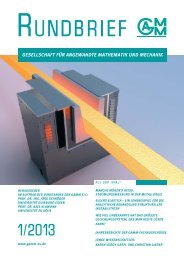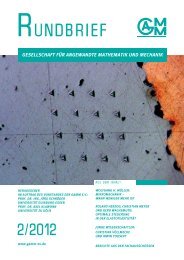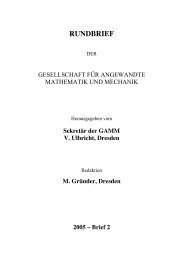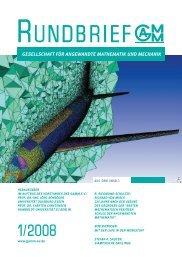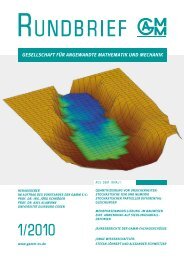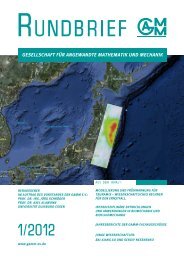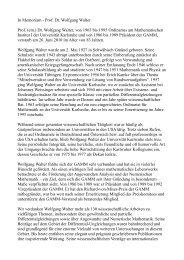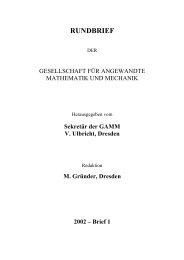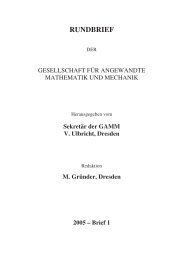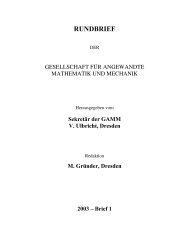GAMM Rundbrief 2002/Heft 2
GAMM Rundbrief 2002/Heft 2
GAMM Rundbrief 2002/Heft 2
You also want an ePaper? Increase the reach of your titles
YUMPU automatically turns print PDFs into web optimized ePapers that Google loves.
58 Wissenschaftliche Tagungen<br />
Gent in 1999. The conference provides a forum for the presentation and discussion of<br />
research in the general area of multigrid methods.<br />
Topics<br />
Multigrid methods, focussing on robustness, adaptivity, algebraic multigrid, wavelets,<br />
parallel methods, optimization and inverse modelling, software and tools.<br />
Applications of multigrid, paticulary in computational fluid dynamics, porous media<br />
flow, computational mechanics, chemical engineering, biotechnology and statistical<br />
physics.<br />
Abstracts<br />
Please submit your abstracts by May 32st.<br />
Registration / Information<br />
Jochen Hittler, Tel: ++ 49 (0) 6221 54 88 15<br />
Oktavia Klassen, Tel: ++ 49 (0) 6221 54 88 54<br />
Simultation in Technology Center<br />
Im Neuheimer Feld 368<br />
D-69120 Heidelberg<br />
fax : ++ 49 (0) 6221 54 88 60<br />
mail: emg02@iwr.uni-heidelberg.de<br />
web: http://www.wir-bawue.de<br />
October 07 – 11, <strong>2002</strong><br />
Moving Discontinuities in Crystalline Solids<br />
Advanced School: Coordinated by F.D. Fischer, Montanuniversität, Leoben, Austria M.<br />
Berveiller, LPMM - ENSAM, Metz, France<br />
The thermomechanical behaviour of most of the crystalline solids is controlled by:<br />
1.thermoelastic deformations of the crystal lattices,<br />
2.inelastic deformations resulting from nucleation, motion and annihilation of lattice<br />
discontinuities. Associated with these defects are discontinuities of the thermoelastic<br />
behaviour and (or) inelastic strain discontinuities. The “static” part of the problem<br />
(determining the stress fields related to these defects) is well known since the sixties.<br />
More recently, a great interest was devoted to problems connected with the movement<br />
of discontinuities, and with a more generalized definition of “forces”. Some of these<br />
problems are listed below:<br />
1. What is the thermodynamic (driving) force responsible for the evolution of the<br />
interfaces whenever the chemical composition is changing or not?<br />
2. How is this interface motion transmitted to the level of the Representative Volume<br />
Element (RVE)?<br />
3. How is the thermoelastic behaviour of the RVE affected by moving boundaries,<br />
diffusion, plastic flow etc.?<br />
4. Which are the effects of the coupling between different mechanisms: plasticity and<br />
recrystallization, plasticity and phase transformation, diffusion and phase<br />
transformation, plasticity and diffusion etc.?<br />
5. Which algorithms are available to describe the change of the microstructure. The<br />
aim of the course is to present research results of the last ten years as well as tools<br />
for an algorithm formulation concerning the topics previously discussed.



